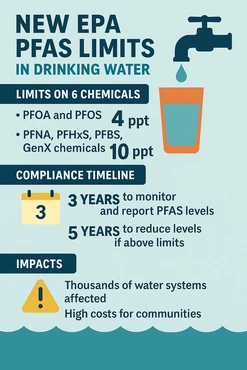The 'forever chemicals' are thought to have a wide range of health consequences
April 29, 2025
Key takeaways
– New EPA rule sets strict enforceable limits on six PFAS chemicals, including 4 ppt for PFOA and PFOS
– Public water systems have five years to comply, but experts warn of steep financial burdens
– States and industries face pressure to adapt quickly amid legal, environmental, and economic complexities
In a historic move to address the growing health threat of forever chemicals, the U.S. Environmental Protection Agency (EPA) is enacting new regulations covering PFAS,a class of seemingly ubiquitous toxic chemicals that can cause kidney cancer, thyroid disruption, reduced responses to vaccination, and other health problems.
These forever chemicals have contaminated drinking water across the nation and threaten as much as 45% of the nations tap water, according to a 2023 study by the U.S. Geological Survey.
According to an EPA news release, the agency will pursue several measures related to PFAS, including the following:
- Develop effluent limitations guidelines (ELGs) for PFAS manufacturers and metal finishers and evaluate other ELGs necessary for reduction of PFAS discharges
- Enforce Clean Water Act and TSCA limitations on PFAS use and release to prevent further contamination
- Work with Congress and industry to establish a clear liability framework that operates on polluter pays and protects passive receivers
- Address the most significant compliance challenges and requests from Congress and drinking water systems related to national primary drinking water regulations forcertain PFAS

Drinking water the first target
The new rules are parrt of theNational Primary Drinking Water Regulation (NPDWR), formally enacted this month by the EPA, setting legally enforceable limits on six types of per- and polyfluoroalkyl substances (PFAS) in public water supplies.
Announced on April 10, 2024, the rule caps the amount of PFOA and PFOS at 4 parts per trillion (ppt)among the most stringent thresholds ever imposed by the EPAand establishes new 10 ppt limits for four other PFAS compounds: PFNA, PFHxS, PFBS, and GenX chemicals (HFPO-DA).
The regulation also includes a novel hazard index for mixtures of two or more of the latter four substances. The rule follows more than a year of public input and over 120,000 public comments.
A timeline for compliance
Public water systems now face a multi-stage timeline:
-
3 years to complete initial monitoring and publicly report PFAS levels.
-
5 years to reduce PFAS contamination if levels exceed the new Maximum Contaminant Levels (MCLs), using EPA-endorsed technologies such as granular activated carbon, anion exchange, and reverse osmosis.
The EPA estimates that between 6% and 10% of U.S. public water systems will require remediation, affecting up to 66,000 systems across the country.
To ease the financial burden, the agency also announced $1 billion in funding to assist small and disadvantaged communities, part of a broader $21 billion PFAS-related infrastructure investment under the Bipartisan Infrastructure Law.
Environmentalists pleased
In pursuit of non-stick and non-stain convenience, the widespread use of PFAS in products has resulted in pervasive contamination of Americas drinking water and threats to our health,” said Environment America Research & Policy Centers Clean Water Director and Senior Attorney John Rumpler released the following statement:
“The only way to solve this major pollution problem is to phase out the use of these toxic chemicals, halt further releases into our waterways and ensure comprehensive cleanup where contamination has already occurred,” Rumpler said.
Industry and states alarmed
While the rule has been applauded by environmental and public health groups, it has raised alarm among utility operators and manufacturers. Industry representatives warn that compliance costs could exceed $3.8 billion annually, far higher than the EPAs estimate of $1.5 billion, potentially burdening ratepayers with hundreds to thousands of dollars in annual costs.
Many companies also argue that PFAS are essential for certain critical applicationsincluding medical devices, semiconductors, and components used in the clean energy transitionand that regulating them too aggressively could disrupt supply chains or shift manufacturing abroad.
Meanwhile, states that had adopted their own PFAS limitsfrom California to New Yorkmust now reconcile those rules with the federal standards. Some will need to strengthen their existing guidelines, while others will shift enforcement to federal oversight. The result is a complex, evolving regulatory patchwork that has left consumers and local agencies scrambling for clarity.
Whats next
The PFAS drinking water rule is just one part of a broader EPA PFAS Strategic Roadmap, which aims to tackle PFAS pollution across environmental systems.
Next on the docket: the likely designation of certain PFAS as hazardous substances under the Comprehensive Environmental Response, Compensation, and Liability Act (CERCLA), also known as the Superfund law. That change could dramatically expand cleanup liability for polluters and municipalities alike.
Additional regulations are expected under the Resource Conservation and Recovery Act (RCRA) and the Clean Water Acts National Pollutant Discharge Elimination System (NPDES), placing more pressure on wastewater treatment operators and their communities.
Newsletter
Sign up below for The Daily Consumer, our newsletter on the latest consumer news, including recalls, scams, lawsuits and more.
.newsletter-form {
display: flex;
max-width: 400px;
margin: 20px auto;
background: #f8f9fa;
padding: 10px;
border-radius: 8px;
box-shadow: 0 4px 6px rgba(0, 0, 0, 0.1);
}
.newsletter-input {
flex: 1;
padding: 10px;
border: 1px solid #ccc;
border-radius: 5px 0 0 5px;
font-size: 16px;
outline: none;
}
.newsletter-input:focus {
border-color: #007bff;
}
.newsletter-button {
background: #2976D1;
color: white;
border: none;
padding: 10px 15px;
font-size: 16px;
border-radius: 0 5px 5px 0;
cursor: pointer;
transition: background 0.3s ease;
}
.newsletter-button:hover {
background: #0056b3;
}
#EPA #rule #targets #PFAS #chemicals #drinking #water